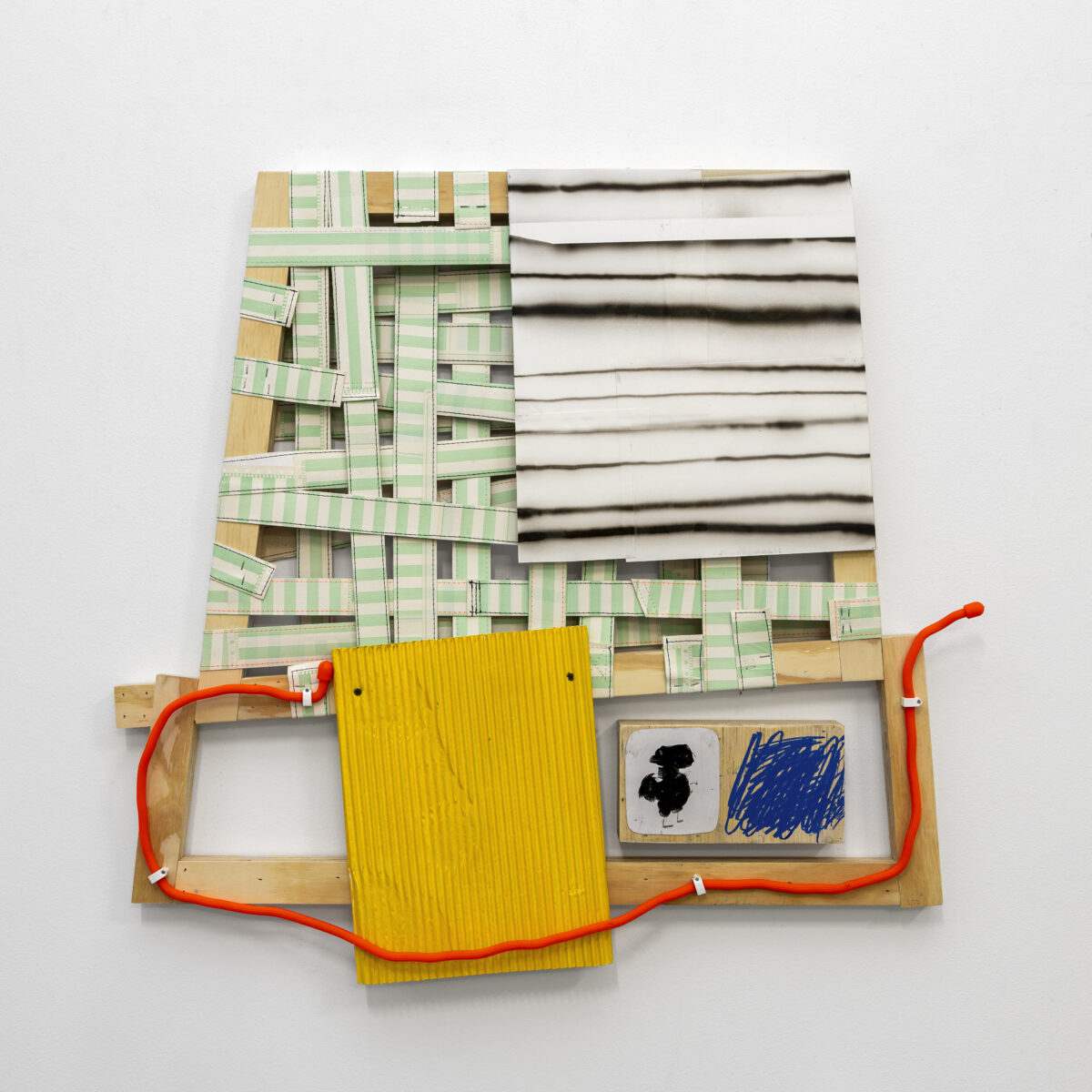
Courtesy of Monica King Contemporary
Fresh off his show at Monica King Contemporary, Taylor Anton White sits down with Erik Sommer to talk about green studio chairs, William Anastasi, stuffed macaws, and the importance of mimicry.
I get excited when something I do is interpreted in a totally different way than I intended.
(ES) Describe your work for us.
(TAW) One of my primary drives when making art is creating contradictions, problems, and jamming things together that are unrelated and discordant. I am interested in the wrestling match that often happens with a good problem in a painting, and the solving of that problem is something that really keeps me coming back to the studio every morning. Most things I make are generally large, but small paintings have been really exciting me lately. As for materials, I use just about anything I can get my hands on.
Do you see elements of pop culture creeping into your work?
Pop culture references in my work most often happen kind of by accident. I might make a decision to use a specific shape and that can be read by someone else as an intentional reference to something, but I am usually employing something like that because I love the formal qualities of it, rather than what it signifies. I get excited when something I do is interpreted in a totally different way than I intended. I think I would be quite bored with the “See? Get it?” approach with intentional references.
That comes through with your titles as well, how they are like little poems.
For me, titles are never really intended to describe or really even to directly reference my work. I am most interested in using them as sort of a parallel conversation, maybe about something which is completely unrelated, but when paired together with the image they just feel right to me.
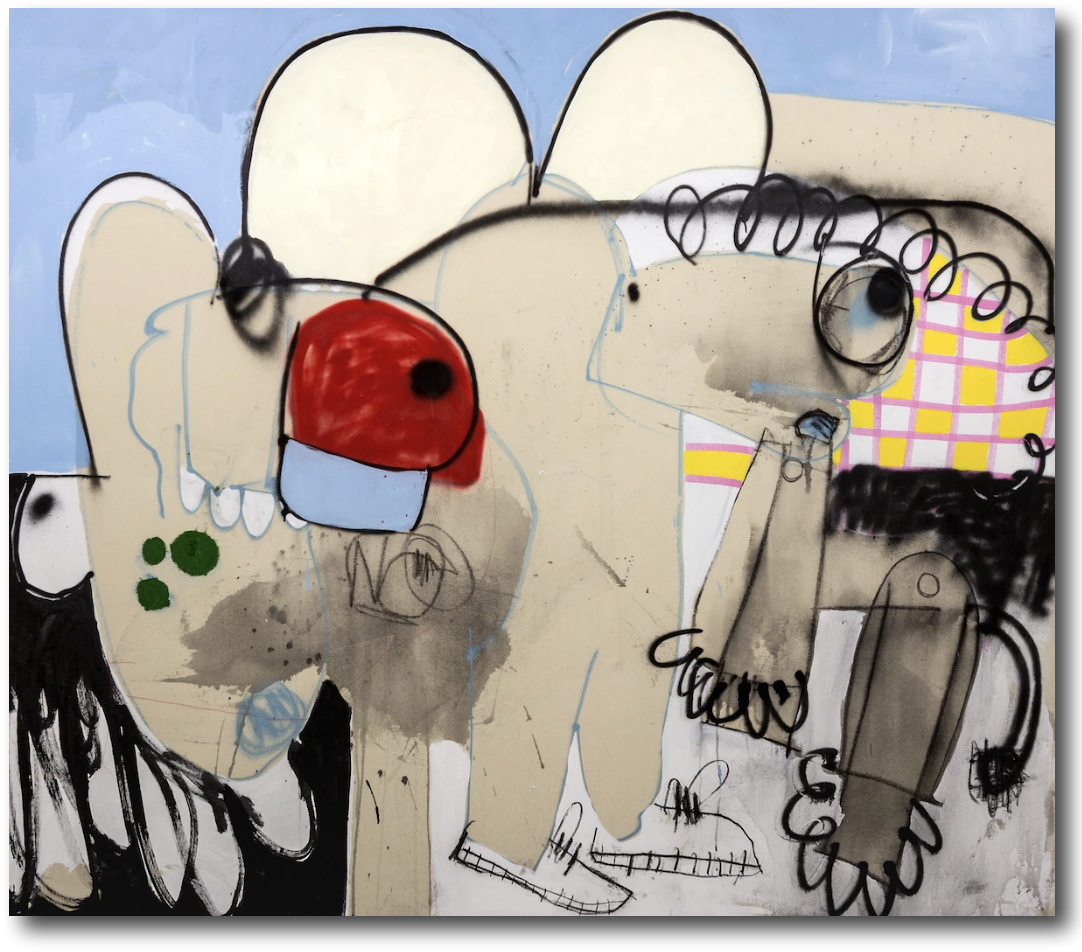
Courtesy of TWFINEART
You live in Virginia. How do you think this has influenced your work?
When I first started really working seriously, I lived in this suburban neighborhood in Stafford, Virginia. It is a super boring town of mostly shopping complexes and minivans. I was just super bored, and I started just arbitrarily making drawings in my basement. Then I started going to college, and I stumbled into the art program they had, and I was immediately hooked. My work just totally took over the basement of my house, so we eventually moved to Richmond, Virginia so I could find a larger industrial type space to work in. I really like working in Virginia, for me it just feels right. I am in New York and other cities on a fairly regular basis, and those trips work like a battery charger for me. I feel like working outside the major focal points in the art world helps me focus. I need to be bored to end up making work to entertain myself.
What do you remember about those early drawings and paintings?
I was really intimidated by painting. I had this tremendous painting professor named Joseph DiBella, who really could see that I just wanted to draw, and he seriously pushed me to think about painting simply as drawing. He would often force me to make paintings without a paintbrush, with all kinds of other tools like sticks, brooms, my elbows, using only my non-dominant hand – I even made a painting in school by attaching it to the side of a truck and chasing it on foot while painting. I was just running down the road with art supplies trying to make a drawing. Such fun. Then I discovered all kinds of artists that had worked in this manner, and I was really fascinated by that. William Anastasi, Cy Twombly, and several others that sort of worked in this bizarre manner, or that operated with odd restrictions that would force new things to happen in their works.
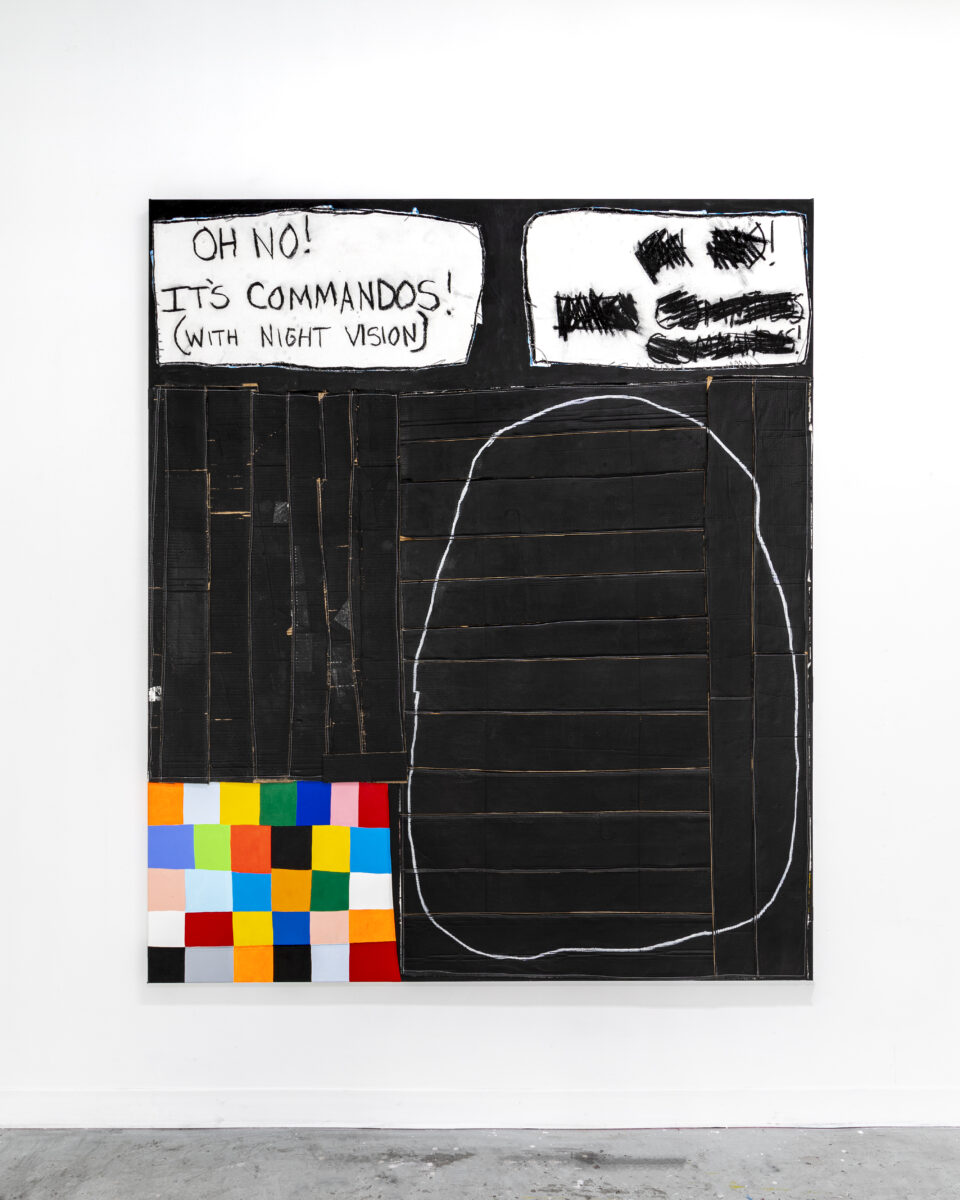
Courtesy of Monica King Contemporary
Any other artists you are looking at today?
Have you seen Michael E. Smith? I love this guy. He has this work with a stuffed macaw with a laser pointer in its mouth, and the neon green laser makes this absurd line across the gallery. It is just fantastic.
Also, Richie Culver. I like what he is doing with shoes and concrete and plastic lawn chairs. Brilliant. It is so unheroic.
Robert Nava has really impressed me over the last few years as well. That guy is really on to something good; he is totally fearless and the work he is making just roars.
Lastly, Hannah Beerman, who is really doing some incredible things with materials in her work. It is always so brazen, hilarious, and totally unexpected. She has this one painting with a hair dryer, a pillow, and some dog treats glued to it. When I saw it I felt like something exploded in my brain. I laughed and laughed.
Your work is very recognizable. How long did it take for you to find your visual voice?
Honestly, I used to make a lot of work that I knew felt very derivative, or at least it felt that way to me. I would land on an idea that was similar to somebody else’s, and had to work through that and find a way to wrestle that into my own language. I had to work through that phase of mimicry, but I think that is a pretty natural thing for an artist to do in the beginning. All art comes from other art, and I think it is more important to just pull the trigger and make your work instead of hesitating to make sure your ideas are things that have never been done before. For me, I had to just plow through that phase until my own voice started to appear.
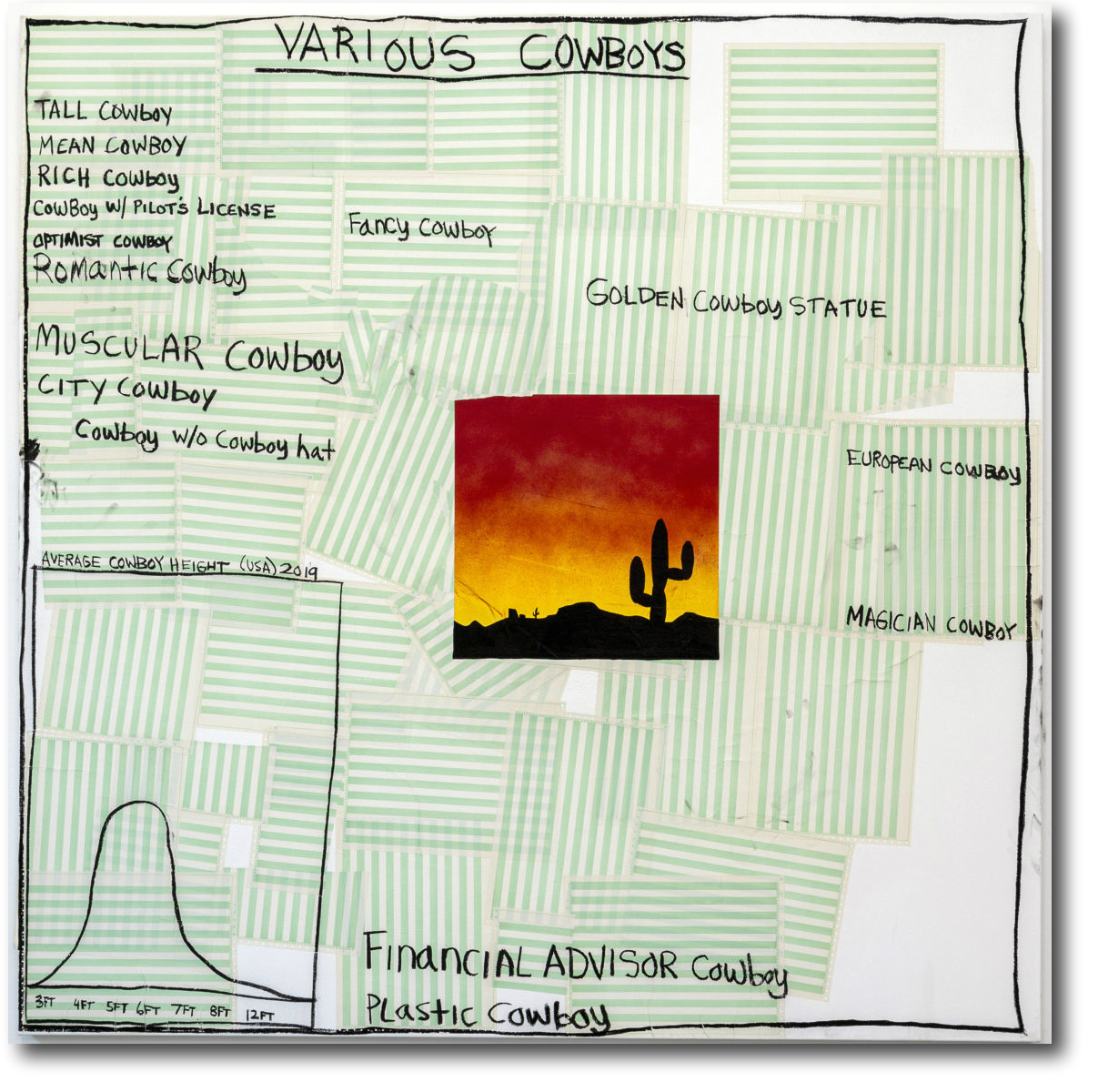
Courtesy of Monica King Contemporary
Do you consider yourself a painter?
I don’t know. I would say I am an artist. I do not think there is anything wrong with saying I am a painter, but I think I am more interested in treating painting like a construction project than I am in “painting” a painting. I am more interested in trying to see it like an assembly and construct it and sew it and bolt it together than I am in creating an image with a brush. But painting is a huge broad niche. You can do anything now. You don’t need paint to make paintings.
I have always been kind of reluctant to label myself because I am worried that that type of thinking or that kind of language in your head can start pigeonholing what you do and make. I think that kind of labeling can restrict some of my impulses, so I just think about it like: “I am going to make a thing. Ok, now I am making a thing. Look at this thing.”
I was thinking recently of a picture I saw of a green chair in your studio. Are you interested in making more three-dimensional work?
Absolutely. The green chair- it was in my studio. I was screwing around with paint and cardboard and I just started throwing it together, sewing pieces of cardboard together into these panels. Then I started stapling it to this wooden chair, stapling through the cardboard onto this wooden chair. And then I was like, let’s just cardboard over every part of this chair. So I did, but there are these parts that are not cardboard, where I ran out of cardboard. I didn’t think my way through it. I just intuitively did it until I ran out of the cardboard.
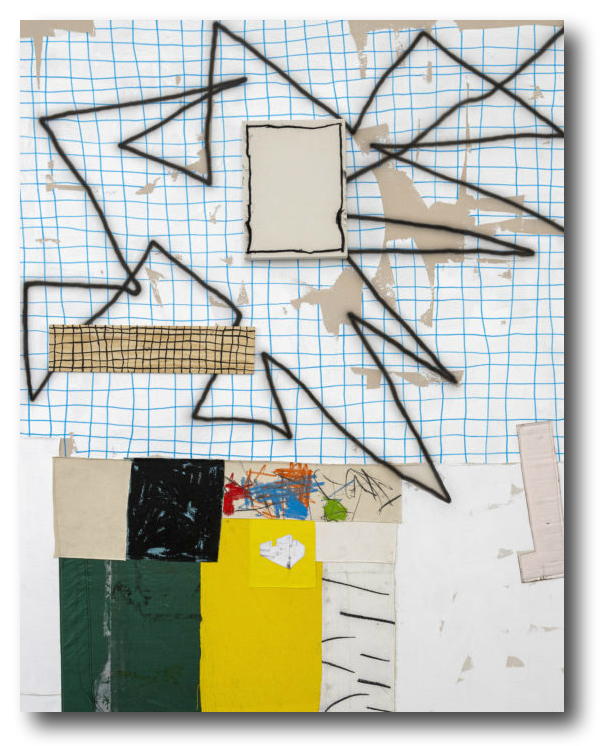
Courtesy of Monica King Contemporary
Then I started thinking about the conceptual difference between a painting on canvas and wooden stretcher bars which were purchased from an art supplier, and a wooden IKEA chair with painted cardboard stapled to it. What is the difference? It made me laugh and laugh, so I just went with it.
It turned out very well.
I really enjoyed it and it just made me laugh and laugh.
I have often found that things I make that I am the most happy with are things that were made when I was trying to distract myself from something. Things created in the periphery.
Last question: what is your favorite color?
I do not have a lot of green in my paintings but I really like green.
No wait, there is this one color: fluorescent orange. When you look at it, it just looks like it is from space.
To see more of Taylor Anton White’s work visit his website and Instagram page.
